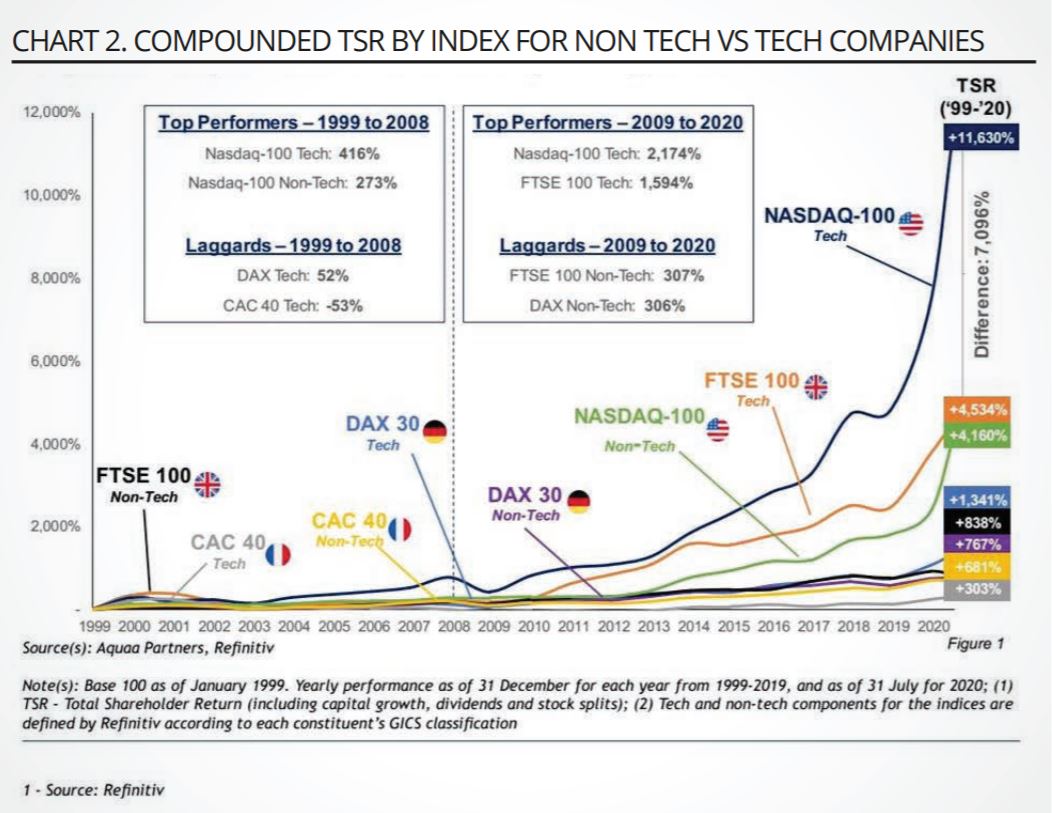The last few weeks have brought on a wonderful blossoming of acronyms which have kept this market observer endlessly amused. FOMO (fear of missing out) combined with TINA (there is no alternative) have produced a huge momentum-based surge in share prices for FAANGs.
These wonderful acronyms have now combined with a profusion of letter based scenarios – we started with hopes of a V-shaped recovery which then turned into a more dismal U-shaped one, but not before many of us thought a W-shaped recovery might emerge which has in turn be super ceded by a K shaped recovery. Scratch beneath the surface patina though of this wonderful jargon and old debates bubble up, wearily familiar to anyone with more than a passing knowledge of factors and risk premia.
I discussed in the Q2 edition of Beyond Beta the growing concerns about concentrated returns patterns i.e. broad indices being pushed forward by a small sub section of mega large cap stocks. There are some very real concerns here but in truth most benchmark indices have always been vulnerable to dominate sub sections of the market – in previous decades we have worried about banks or resource stocks or even a previous generation of tech stocks in the early years of this new millennium.
Chart 1 should also remind us not to get too carried away with worries about concentration. Sure, the FAANGs are important but the chart shows the share price for Nvidia, a graphics microprocessor business that is riding two concurrent thematic transformations – the cloud and the rise of eGaming. The sheer rapidity of the ascent of Nvidia’s share price is arguably even more astonishing than the rise of the FAANGs.

Something is afoot that is more wide ranging than just a few big stocks dominating an index. That ‘something’ is the age-old debate between growth and value. What the FAANGs and Nvidia share in common is the moniker of a growth stock, in this case built on technology. By contrast value stocks seem marooned, devoid of interest and lagging ever further behind the wider market. Thus, it comes as no surprise when popular US day trader Dave Portnoy recently declared that Warren Buffett was past his prime and that a new world of investing has arrived – one presumably populated by lots of tech stocks favoured by Dave.
It is easy to mock the Barstool investing hero but more than a few finance professionals reckon that Portnoy has a point. Paul Cuatrecasas, who previously founded Alegro Capital in 2003 and also co-founded ARC Associates in 1993, is behind a new research venture called Aquaa Partners Investment Research. Their latest research paper is worth a read on this subject – it is called The death of value investing and the dawn of a new tech driven investment paradigm. I will pull out a few choice bits, and accompanying charts – truly are extraordinary. Chart 2 illustrates total shareholder returns since 1999 for key tech and non-tech indices.

“In the 22 years since 1999, the Nasdaq 100 Tech index has delivered a TSR to investors of 11,630%. This compares to the Nasdaq 100 non-tech index TSR of only 4,543% (despite this non-tech index including Amazon and Alphabet). The TSR since 1999 of the Nasdaq 100 Tech index was almost 13 times greater than the TSR of the FTSE 100 NonTech index (838%).
“Chart 2 also illustrates how these differences have become even more pronounced since 2009 as tech began to pick up exponential speed. the TSR of the Nasdaq 100 Tech index from 2009 to 31 July, 2020 was six times greater than that of both the FTSE 100 NonTech index and the DAX Non-Tech index.”
ETF Insight: Is the value factor dead?
In other words, over a 22-year period technology stocks have delivered an approximate return 15 times greater than non-technology stocks, despite the dot-com collapse from 2000 to 2003.
Even in the last five and half years, since January 2015, the Nasdaq 100 has delivered a TSR close to 3.5 times greater than that of the average of the non-tech indices. Ah, but surely all these amazing returns have come with much greater risk? Not so, says Aquaa. They point to Chart 3.

Their chosen measure of risk is based on calculating the maximum point of loss in each year since 1995 from the first day in the year of trading.
Yearly averages are calculated, and the figures amalgamated. The exercise is then applied to both tech and non-tech stocks. Again, the Nasdaq 100 index is used as the source of tech sector data, while the non-tech sector is measured by the average of non-tech data for the FTSE 100, CAC 40 and DAX 30 indices. According to the Aquaa report, “in the 12 years from 2009 to 2020 (seven months to 31 July, 2020), the average of the maximum point of loss for the tech sector was only 7.6%, compared to 12.7% for the non-tech sector”.
So, what is the driver of this extraordinary transformation – which the report reckons could continue for many years hence? “It is the effect of Moore’s Law materialising in all industries as the world becoming more technology dependent. This force is only to going to grow, despite the inevitable market cycles.”
And what happens if the regulators come after the tech giants? “If the concern is that larger tech companies are at risk of being broken up by regulators, then what gets spun out, split off or severely taxed can, and likely will, still grow.
“Our view is that when Big Tech falls, smaller tech develops to take its place. The tech industry is characterised by a faster rate of change than traditional industries. This fast rate of change lends itself to greater adaptability and growth.”
As for concentration risk, there is always the next generation of businesses in new sectors coming along to challenge this year’s FAANGs. Cue the emergence of AI, robots, drones, electric selfdriving vehicles, 5G, VR, AR, holograms, renewable energy, plant-based meat, vertical farms, 3D printing, blockchain. “All this advanced tech is emerging now and is growing exponentially fast.”
These concurrent transformations are, in part, being helped along by a wall of money flooding intoventure capital. In 2019, approximately $161bn of venture capital was invested in 22,645 companies in North America and Europe, yielding an average of $7.1 million invested per company, By contrast, in the 'dot-com boom' years of 1998, only $6 billion of venture capital was invested in only 979 companies, the majority of them in North America.
Add this all up and you see that growth investing is “unconstrained it is not a bubble”. On a long-termbasis, growth investing in tech delivers a superior balance of risk-reward, i.e. “value”, compared to the traditional value stocks. Tech stocks are the new value stocks. “In simple terms, value investing is dead on its feet.”
Back to that old debate again! It is difficult to argue with the growth advantage in the current macro-economic environment – which by the way could change in a heartbeat – but I am not so sure about the death of value.
I would make a number of points to counter this. The first is that I have never seen value and growth as opponents. I am perfectly happy to run a large portion of growth alongside a smaller portion of value. That is especially true for different geographies – value has real virtues in Europe and the EM ex-China markets. Less so in the US.
Next up I am a little uncertain where to draw the line between tech and non-tech. In my experience a great many ‘legacy’ non-tech businesses and actively building huge tech businesses. Walmart is a huge tech business. The sports retailing mammoth the Frasers Group (Sports Direct) has an enormously successful online business. Is Easyjet or Ryanair a legacy value stock or are they pioneers of internet-enabled travel? Put simply, many legacy businesses are now digitising their operations and products like crazy – and making huge amounts of money.
Next up my concern – and hope – is that the US and China are about to enter a technology fuelled face off. China might react by stopping inward foreign investment in its tech businesses to safeguard its national interest. That could throw a spanner in the whole argument for tech.
Lastly, I also have my deep suspicions around tech profitability and margins, best explained by a small example. I have a few cloud-based services which seem to become ever more expensive. Like many consumers with endless online subscriptions I have noticed that tech inflation – sure you get more product but you pay more for the experience – has become a real challenge. That is wonderful for the margins of the tech businesses but as they become large parts of consumer expenditure, and tech service inflation becomes more noticeable, I would expect to see real pushback on those massively profitably margins.
Searching for better value metrics
Société Générale strategist and permabear Albert Edwards has made a much broader point that backs up this narrow example. In a paper from earlier in the summer, Edwards reminded investors that in 1999 and 2000, investors were equally convinced that ever higher tech share prices would be backed up by ever higher tech earnings. Then a recession hit and within 12 to 18 months those supposedly defensive tech earnings started to crumble and fade. Tech turned out to be ever so slightly more cyclical than everyone had expected. As a consequence, valuations started to crumble, and the tech sector wilted and waned for a number of years.
So, in sum, it is easy to accept that growth has the upper hand at the moment but who is to say that advantage will persist? Logic and experience suggest that eventually markets mean revert and value kicks back in – and if it does not, then rather than worry about value, we will all collectively need to rethink how we talk about investment styles and factors. Which perhaps prompts the observation that the old definitions dividing growth from value are increasingly not fit for purpose. Maybe we need a new factor set to define a new world order?
David Stevenson is a columnist at the Financial Times and strategic adviser at ETF Stream
This article first appeared in the Q3 2020 edition of Beyond Beta, the world’s only smart beta publication. To receive a full copy,click here.


